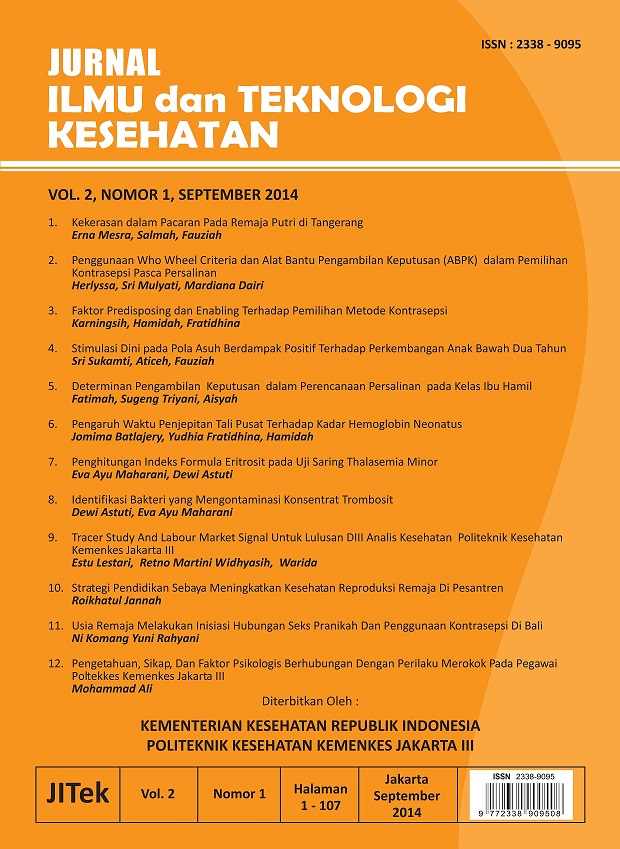Main Article Content
Abstract
The date based from Kemenkes 2011 is acceptor of family planning 76% used the metode of contraceptive short time and 24% used metode of contraceptive long
time. So the need to do research with the purpose is identify factors predisposing and enabling the metode of contraception. This research is quantitatif study with design a cross sectional using primary data. The samples this research is in the mothers the ages of fertilited in in fertile couples subdisterict health center sunday market from July to October 2013, with total samples is 120 respondens. The result univariate analyse is 60.8% used the metode of contraception short time and the metode of contraception long time 39,2%. From the result bivariate analyse is education variables with p- value = 0,046 and employment variables with p-value= 0,036 have a relationship with the metode of contraception in fertile couples. The result research is the personnel health must to give support and health education to mothers the ages of fertilited about selection the metode contraception is rational. The purpose health education is to preventive awanted pregnancy.
Keywords
Article Details
Authors who publish with this journal agree to the following terms:
1. Authors retain copyright and grant the journal right of first publication with the work simultaneously licensed under a Creative Commons Attribution-ShareAlike License that allows others to share the work with an acknowledgment of the work's authorship and initial publication in this journal.
2. Authors are able to enter into separate, additional contractual arrangements for the non-exclusive distribution of the journal's published version of the work (e.g., post it to an institutional repository or publish it in a book), with an acknowledgment of its initial publication in this journal.
3. Authors are permitted and encouraged to post their work online (e.g., in institutional repositories or on their website) prior to and during the submission process, as it can lead to productive exchanges, as well as earlier and greater citation of published work (See The Effect of Open Access).
References
-
Ama, N.O., & John, O. 2007. A Multivariate Approach to Determinant of Contraceptive Use Among Migrants and Refugees in Bostwana. Jurnal of Family Welfare Vol. 53 No.2, Desember 2007.
Anashir. 2012. 10 Negara dengan Penduduk Terbanyak di Dunia. http://www.anashir.com diakses tanggal 28 Februari 2013
Bertand, J.T. 2009. Audience Research For Improving Family Palnning Communication Program Community and Family Study Center. Chicago.
Biro Pusat Satistik. 2010. Jumlah dan Disteribusi Penduduk. http://sp2010.bps.go.id diakses tanggal 28 Februari 2013.
Fienalia, R. A. 2012. Faktor-Faktor yang Berhubungan dengan Pemilihan Metode Kontrasepsi Jangka Panjang (MKJP) di Wilayah Kerja Puskesmas Pancoran Mas Kota Depok Tahun 2012 (Skripsi). Fakultas Kesehatan Masyarakat Universitas Indonesia, Depok.
Green, Lawrence W & Kreuter, M. W. 2005. Health Program Planning. New York : Mc Graw Hill.
Hartanto, H. 2004. Keluarga Berencana dan Kontrasepsi. Jakarta: Pustaka Sinar Harapan.
Hidayat, A. A. 2007. Metode Penelitian Kebidanan dan Teknik Analisis Data. Jakarta : Salemba Medika.
Kamal, N., Cindy, L., & Omar , R. 2007. Determinant Of Contraceptive Use In The Urban Slums Of Bangladesh. Bangladesh : Independent University.
Kemenkes Republik Indonesia. 2011. Profil Data Kesehatan Indonesia tahun 2011. Jakarta : Kementerian Kesehatan Republik Indonesia
Notoadmodjo, S. 2010. Promosi Kesehatan Teori dan Aplikasi. Jakarta : Rineka Cipta.
Pusat Pengembangan dan Penelitian BKKBN. (2012). Faktor-Faktor yang Mempengaruhi Penggunaan Metode Kontrasepsi Jangka Panjang di Enam Wilayah Indonesia. http://www.bkkbn.go.id diunduh tanggal 25 Februari 2013.
Sugiyono. 2009. Metode Penelitian Kuantitatif dan Kualitatif R&D. Bandung : Alfabeta
Widyastuti, L. 2004. Faktor - Faktor yang Mempengaruhi Pemakaian Kontrasepsi di Sulawesi Utara dan Nusa Tenggara Timur Tahun 2002. Skripsi : Fakultas Kesehatan Masyarakat Universitas Indonesia, Depok.
